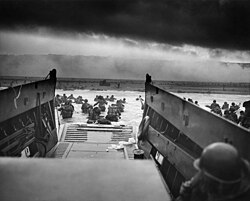Into the Jaws of Death

Taxis to Hell – and Back – Into the Jaws of Death (engl. „Taxis in die Hölle – und zurück – in den Rachen des Todes“) ist ein historisches Foto, das der U.S.-Army-Fotograf Robert F. Sargent am D-Day, dem 6. Juni 1944 aufnahm. Es entstand am US-Landungsabschnitt Omaha Beach in der Normandie und zeigt Soldaten der 1. US-Infanteriedivision beim Verlassen eines Landungsbootes (LCVP) der Küstenwache, um den Strand zu erstürmen.[1]
Der Titel Into the Jaws of Death ist ein Zitat aus dem Refrain in Alfred Tennysons Gedicht The Charge of the Light Brigade (Der Angriff der Leichten Brigade),[2] das sich auf ein Ereignis während der Schlacht von Balaklawa bezieht. Die Szene wurde 1998 im Hollywoodfilm Der Soldat James Ryan filmisch zitiert.
Einzelnachweise
- ↑ Scott T. Price: U.S. Coast Guard at Normandy. U.S. Coast Guard Historian's Office, abgerufen am 23. Mai 2012.
- ↑ Charge of the Light Brigade (Memento vom 13. Mai 2007 im Internet Archive)
Weblinks
- Taxis to hell – and back, Beschreibung in der Library of Congress
Auf dieser Seite verwendete Medien
A LCVP (Landing Craft, Vehicle, Personnel) from the U.S. Coast Guard-manned USS Samuel Chase disembarks troops of Company A, 16th Infantry, 1st Infantry Division (the Big Red One) wading onto the Fox Green section of Omaha Beach (Calvados, Basse-Normandie, France) on the morning of June 6, 1944. American soldiers encountered the newly formed German 352nd Division when landing. During the initial landing two-thirds of Company E became casualties.
